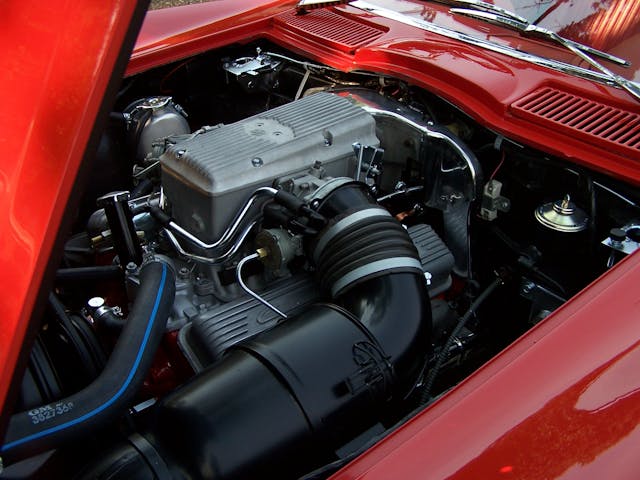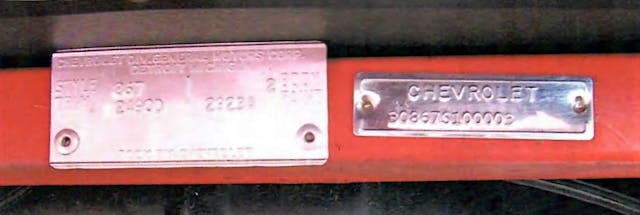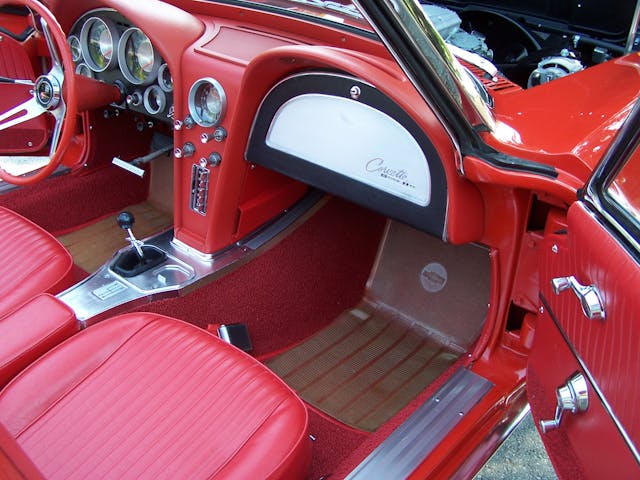Bought by a teen for $1500, this ’63 Corvette is now priceless
Even in his teenage years, Brian Richardson had an eye for Chevrolet Corvettes. Turns out he also had a nose for buried treasure.
Richardson and his identical twin brother, Bruce, bought and sold Corvettes in northern California to help finance their college education in the 1970s, but Brian could never part with one of them: This 1963 convertible, VIN 30867S100003, the earliest-known second-generation (C2) Corvette in existence and now a priceless collectible.
“My mom worked for the DMV, and Brian wanted a fuel-injected Corvette,” Bruce says of his brother, who died unexpectedly two months ago. “He came up with the brilliant idea to have her run the first 20 serial numbers, and he found #00003 in Los Angeles.”
Since Mom Richardson was traveling to Los Angeles anyway, she drove to the address registered with the DMV and spoke to the owner’s wife, who shared two pieces of important information: 1. The car didn’t run, and 2. Her husband had just lost his job. Those two negatives added up to a positive for young Brian, who recounts the story in Larry M. Galloway’s book, Corvette: 1963–1967.

“I flew down soon thereafter and was able to see the car through a garage window,” he told Galloway. “… Later I made a deal with the owner over the phone for $1500. The next weekend my brother and I drove down and picked it up.”
When there simply isn’t another one like it, a car’s value is impossible to pinpoint—or, in the words of our valuation team, priceless. The deal for the Vette—equipped with a 327-cubic-inch, 360-hp V-8 (L84)—was completed on April 26, 1975. Taking inflation into account, the $1500 price tag is the equivalent of $8300 today. As the earliest-production second-gen Corvette in existence, however, it’s in a league of its own. When verified, as this convertible’s status is, the title of “earliest known” holds great weight in the collector market. Such a vehicle can easily sell for more than its top value in the Hagerty Price Guide: In this Corvette’s case, $180,000.
By any measure, Vette was an amazingly shrewd purchase, especially for a 19-year-old college student, but it probably wasn’t all that surprising to anyone who knows the Richardsons.
“We were always into mechanical things, trying to figure out how they worked, learning how to make them work better,” Bruce says. “Our dad died when we were 15. He was a businessman, and he had served as a tank commander in World War II. Our grandfather worked for Lockheed, and all of his tools went to Dad, so we had a lot of them, and we used them a lot.
“When we were 14 or 15, we bought our first car—a three-cylinder, two-cycle German car called an NSU Prince, which is about the size of a Mini Cooper. We drove it around in the back yard. We had go-carts and gas-powered skateboards and …”
Bruce’s wife, Lainey, interjects: “When they were 10, they took apart their mother’s washing machine, fixed it, and put it all back together. Can you believe that? Ten!”

Brian and Bruce went to the University of California-Berkeley and became mechanical engineers. Between them, they have more than 100 patented inventions; Brian specialized in lighting, Bruce in biotech. Brian was also an Olympic bobsledder who competed in the two-man event at the 1992 Winter Games in Albertville, France. In addition to competing, he came up with an innovative sled design that is still in use today. As for Bruce, he and his son, Perry, run AccelRaceTek, a motorsports business in Los Gatos, California, that specializes in high-performance race car training, tech, and service.
In other words, the Richardson brothers never lacked for brains, and Brian’s purchase of a historically significant C2 provides automotive proof.

“It is a genuinely significant car, likely the earliest existing C2 Corvette,” confirms Hagerty contributor and Corvette expert Don Sherman. “Its original fuel-injected V-8 adds to its value, and the ability to trace the ownership chain helps as well.
“Speaking from experience, C2 frames are susceptible to corrosion [rusting] because they were not painted by the manufacturer. Instead, they received a coating of tar-like stuff which didn’t last forever. Since this car apparently spent its life in California, that’s a plus for longevity.”
Not surprisingly, the brothers’ restoration work on the Sting Ray was meticulous.
“The car looked ugly when I bought it,” Brian told Galloway. “It was originally red on red. One of the previous owners painted both the interior and exterior black. They even painted the carpets. The paint job was poor. In many places red was showing. The good news is they didn’t replace the interior. They only painted it. So, I was able to see how it came from the factory.
“I still have the original interior seats, carpets, and door panel covers [the panel shape is slightly different from later production]. The paint on the body looked horrible. The body had only been damaged slightly in the rear. All of the original panels were on the car. As I said, the engine didn’t run.
“I drove the car for a short time and then took it completely apart. At the time, a lot of parts could be bought from Chevrolet. Things like weather strips, glass, and FI parts were still available.”

Bruce adds that his brother “wanted to make it as close to its original configuration as possible. We worked on it and had it running within about a year, and we later did a frame-off restoration and got it into a real nice position. Brian also did a refresh about 10 years ago.”
In addition to the car’s Riverside Red paint and 327 fuel-injected engine, it has a four-speed transmission, positraction axle, radio, and both hard and convertible tops. Its aluminum knock-off wheels and white wall tires were also undocumented options.
The body trim plate does not have a date code, but the National Corvette Restorers Society (NCRS) confirms that #00003 was shipped on August 29, 1962 with a dealer code indicating it was for General Motors’ use.
Knowing that Brian’s C2 is VIN #00003, and there is no recorded account of what happened to #00001 and #00002, he reached out to Corvette author and historian Noland Adams in 2009, hoping Adams could shed some light on their whereabouts. Adams, who died in 2017, wrote back, sharing a lengthy account of what he knew. He stated, without hesitation, that Brian’s car is “the oldest existing Sting Ray.”

“Why haven’t the first two Sting Rays, numbers 1 and 2, been found? I think I know why,” Adams wrote. “… First of all, why build pre-production prototypes? The answer is obvious—build them about two months before the production run is scheduled [to begin] to check fit and function of all new, never-used-before parts. Soon, production of the new model will begin, and ill-fitting or ill-functioning parts must be replaced …
“Another consideration is how the pre-production prototypes were dispatched. Assuming a coupe and a convertible model for the year in question, one example of each body style was scheduled to be destroyed in a barrier test …”
Adams wrote that, considering the importance that GM placed on these crash tests, “I am certain that 1963 pre-production prototypes 1 and 2 were prepared for such a barrier test as quickly as possible … Apparently the next convertible in line was #00003, and it was used as a design check.”

Adding weight to Adams’ findings, Galloway’s book discusses the differences between #00003 and production 1963 Sting Rays. Some (but not all) of #00003’s unique features include:
- The front fender upper to the lower panel bonding strip on the inside of the front fenders behind the Fuel Injection emblem is a hand lay-up part and does not have a ‘jog’ to clear the emblem studs as all jobs that follow do.
- The headlight mechanisms are sand-cast and appear to be manually machined; scribe lines made by the machinist are visible.
- The door outer panels have a cutout at the top rear … The stainless-steel trim bead along the top of the door trim panel does not extend the full length of the door trim.
- The windshield reveal moldings were handmade, as there is evidence of hammer marks and welds on the backside. They fit noticeably better than production moldings.
- The car (originally) had holes in the body for power windows and a right-side rearview mirror, which were filled with factory bonding adhesive (not bondo).
- The luggage compartment rear carpet under the rear deck was salt and pepper, like 1962 models, while the rest of the carpet was red.

Considering what similar Corvettes have sold for in recent years, it’s safe to say that #00003 is worth six figures—maybe even seven. Why does that matter? Because even before Brian’s fatal heart attack, he was thinking about what would become of his Corvette, since his wife Lee, son Ian, and daughter Shannon don’t share his passion.
Now Bruce and Lainey are in the process of selling the historic C2 on behalf of the family.
“We haven’t decided where and when,” Bruce says. “We’re considering Barrett-Jackson Scottsdale, or maybe Mecum Kissimmee (both scheduled for January 2023). And everybody seems to be selling cars on Bring a Trailer these days, so that’s an option, too. We’re still trying to figure it out.”
Knowing the Richardsons, they’ll make a smart choice, just like Brian did in 1975.
Check out the Hagerty Media homepage so you don’t miss a single story, or better yet, bookmark us.



Wish I had the disposable income to buy it and immediately restomod it.
We all know you are joking…Right?
Yep. Slam it to 1″ off the ground and install some 22″ wheels and tires…..not 🙂
Fortunately for the classic car fraternity, you don’t.
Surely not
WOW!! What a great history and experience for the Richardson’s!!!!
That car will be a bright star in someone’s collection!!
Great story. Love hearing these tales of discovery. Personally, I had made a commitment to purchase a black 64″ roadster in 1972 for $1100. It was a trade-in at the Datsun dealer where I was parts manager at the time. Unlike Brian’s car, it was fully running, black with red guts and nowhere near as valuable as his 63′.
Well, it won’t be priceless for too much longer.
Such a vehicle can easily sell for more than its top value in the Hagerty Price Guide: In this Corvette’s case, $180,000.
Add another zero.
Has to be the most productive thing a DMV employee ever did!
And maybe,………. slightly unethical, Hah! Probably even illegal these days.
Well, she raised those two guys, and from the sound of it the country should thank her for that.
LOL
Great story! I once owned for awhile the earliest documented Big Block Corvette. 1965 425HP 396 CI 4 speed with side exhaust. Scary fast. Sold it back to Bill Mock in Oklahoma who has advertised it for $1.4 Million in recent times. Don’t know if he still has it.
The cool factor with his generation of Corvette is unmatched especially when there is a story like this to go along with it.
Maybe GM should buy it back for the Corvette Museum. But dang, what a find, though with that bloodline, I dare say the twins were inspired to do whatever they set their minds to. Nice work ! FWIW, I’ve been almost that lucky twice, though at nowhere near that kind of appreciation – the Hemi Road Runner managed to fund some of my retirement, though I still have the ’56 Precision bass. Those kinds of stories have entertained others probably more than the items themselves.
I hear the comments on where to sell it. Will the person love and cherish it as Bruce did? Or will it be a trophy. Trophies at the houses are cherished for what it says about the size of checkbook. I know of a similar situation with with a cherish vehicle where the owner talked with the houses mentioned. Sold privately, lof less, to ensure it found a caretaker who would cherish it just the same if not more.
Something to think about…
This is so cool. I lived down the street from them when they trailered this home. I remember one of them telling this 16 year old that it was s/n 3 which didn’t mean much to me back then.
It’s a beautiful car. I’d take it.
Considering the design complexity of C2 coupes, I’m surprised the initial pre-production C2s cited in the article were convertibles After all, GM had a lot riding on the game-changing coupes where fit and finish was critical. Has the earliest known C2 coupe ever surfaced?
I don’t believe the article said that the first two were both convertibles. I think it mentioned crash testing one of each.
I’m pretty sure that most people who really care about this car are glad that you can’t afford to buy it. Even mentioning resto-mod is sacrilege.
I agree with Mr. Howell’s comment. How that information was obtained is (was) definitely insider trading. Can anyone go to the DMV and get VIN numbers, names and addresses of cars they are searching for? Not likely. Very stinky!
Remember what year it was…..Privacy was not an issue as it is today. I remember as a kid in the 60’s, I found a license plate in the street. My dad and I called the police department and gave them the license plate number. They happily gave us the the owner’s name and address so we could return the plate to them. Quite a different world now!
Back in 1970’s it was legal and easy to run license plate numbers and VIN numbers through the DMV. I think it cost $2.00 per number. Bruce
I don’t know about today, but about 20+ years ago I traced the cars I bought in the 1960’s at the DMV in North Carolina. 2 Buick GS cars (1970, 1971) and one Corvette (1971). The 1970 Buick was totaled, the 1971 convertible was for sale but was a complete mess (I found the owner’s name and contacted him). The 1971 Corvette was also totaled.
With all the new laws, it is harder today. I recently searched for the history of my current 1966 C-2 roadster since it was originally delivered to the Zone Office in Wichita, Kansas, but even though I checked all the states around there as well as all the remaining Chevy dealers, I could not find any records of the car. I had to send in some money, fill out forms, explain why I wanted the information, etc., and wait, but I did eventually get answers even though all of them were negative.
Back in the day, I think I just loaded the VIN into the DMV site in NC and got the info immediately.
Cheers!